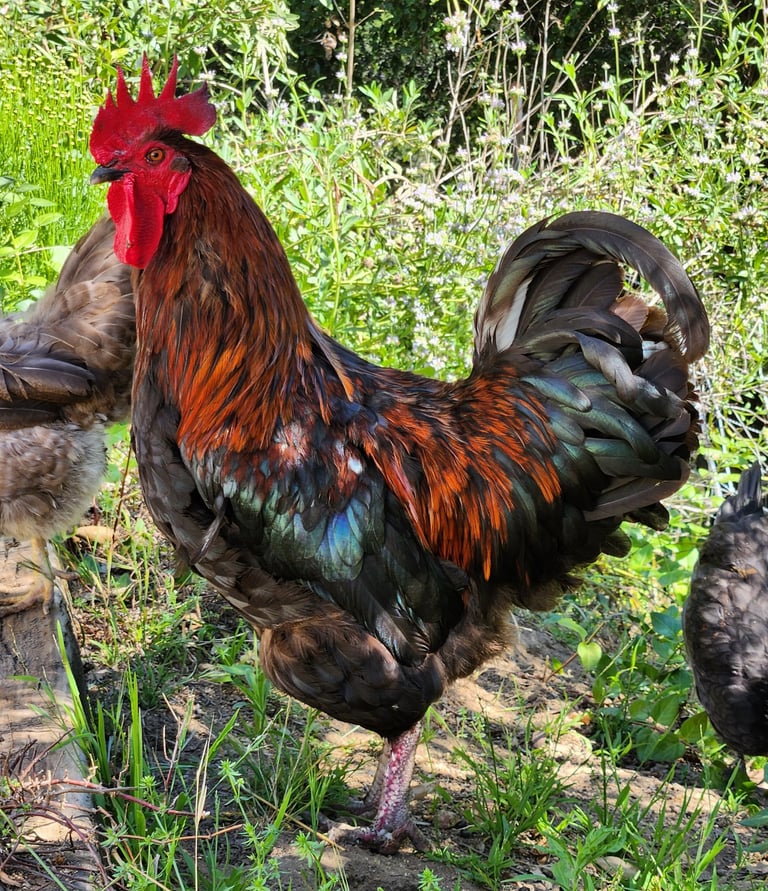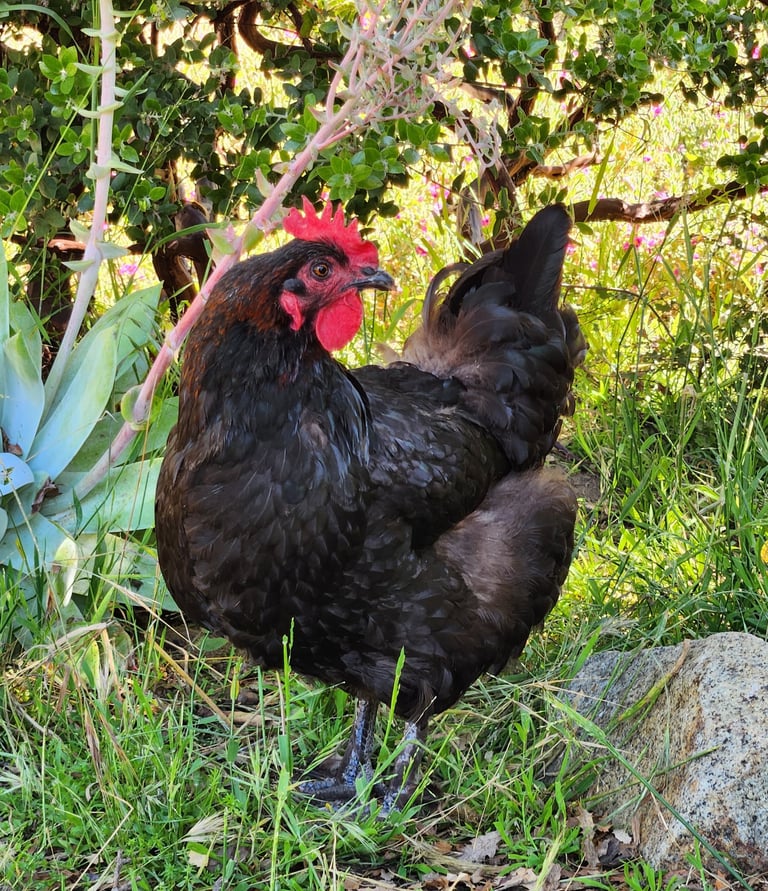French Black Copper Maran Chickens & Why You Should Consider Adding Them to Your Flock
Warren Marsh
6/6/20256 min read


What Is the French Black Copper Marans Breed?
The French Black Copper Marans is a distinctive and historically rich chicken breed that has captivated poultry enthusiasts for generations. Originating from the Marans region of France, this breed was developed in the late 19th century as a dual-purpose chicken, valued for both its meat and eggs. The Marans' pedigree is steeped in tradition, making it not only a valuable asset for backyard flocks but also a prominent breed in competitive poultry exhibitions.
Physically, the French Black Copper Marans are known for their striking appearance. Hens typically exhibit deep black feathering with glossy copper accents on their necks. Males display similar coloration but with more pronounced copper plumage. Their well-rounded bodies and sturdy frames contribute to their attractiveness, as do their gentle and friendly temperaments.
In addition to their beauty, French Black Copper Marans are celebrated for their productivity. These birds are proficient layers of medium to large eggs, which are typically a rich chocolate brown color, enhancing the appeal of any chicken coop. Their egg production sets them apart from many other backyard breeds, making them not only aesthetically pleasing but also practical for egg enthusiasts. Furthermore, the breed is praised for its adaptability, thriving in various climates and conditions, which adds to its allure for new and experienced poultry keepers alike
The combination of the French Black Copper Marans' stunning appearance, historical significance, and reliable egg-laying ability makes it an alluring choice for anyone considering adding new members to their flock. This breed continues to garner admiration, ensuring its place in the hearts and coops of chicken lovers everywhere.
🥚 Egg Production of the French Black Copper Marans
Annual Yield: French Black Copper Marans hens typically lay between 150 to 200 eggs per year, averaging about 3 to 4 eggs per week.
Egg Characteristics: The eggs are notable for their dark chocolate-brown shells, which are the darkest of any chicken breed.
Onset of Laying: Hens usually begin laying at around 24 to 26 weeks of age.
Why Raise French Black Copper Marans?
Raising French Black Copper Marans offers numerous advantages for poultry enthusiasts, making them an appealing choice for both novice and experienced keepers.
Exceptional Egg Production: French Black Copper Marans are renowned for laying beautiful, chocolate-brown eggs, which not only stand out in appearance but also in taste. The depth of color in their eggs is a hallmark of their unique genetics and is often sought after in the farming community. This can serve as a significant selling point for small-scale farmers or home producers looking to make their egg offerings more visually attractive and marketable.
Hardiness and Adaptability: French Black Copper Marans are remarkably adaptable to various climates. This breed has demonstrated its resilience in both cold winters and hot summers, making it a reliable option for farmers located in diverse geographical areas. Their hardy nature enables them to thrive with minimal stress, reducing the need for extensive shelters or temperature control, thereby simplifying management practices for poultry keepers. While their tall comb helps with heat dissipation, it can also make the breed more vulnerable to frost, so ensure there is plenty of ventilation to reduce moisture during winter.
Friendly Disposition: French Black Copper Marans are known for their friendly and sociable personalities, which can enhance the experience of raising chickens. They are typically calm and easygoing, often becoming quite fond of human interaction. This trait not only makes them suitable for backyard flocks but also encourages a positive environment for those new to raising chickens. The manageable temperament of these birds complements their other advantageous characteristics, allowing owners to enjoy both the practicalities of egg production and the companionship of their poultry.
Note on Feather Pecking: It is worth noting that the American line of French Black Copper Marans hens can be prone to feather pecking among each other. It is not uncommon to find many hens missing feathers.
Overall, the French Black Copper Marans present a compelling case for addition to any flock, combining benefits in egg production, adaptability, and ideal temperament, ensuring a rewarding experience for all who choose to raise them.
Choosing Between Pullets and Chicks: What to Consider
When deciding to introduce French Black Copper Marans chickens into your flock, prospective owners must carefully weigh the options between purchasing pullets or chicks. Each choice presents distinct advantages and disadvantages that could impact both the immediate future and ongoing care of the birds. Understanding these factors can help make an informed decision that aligns with one’s preferences and capabilities.
Pullets: Purchasing pullets, which are young hens nearing egg-laying age, often provides the benefit of immediate egg production. This can be particularly appealing for those seeking a quick return on their investment or those who wish to enjoy farm-fresh eggs without the wait associated with raising chicks. They also require less time and effort in terms of initial setup and care, as pullets are more independent and have transitioned beyond the delicate stage of chickhood. For this reason, I recommend the purchase of pullets for new chicken owners.
Chicks: On the other hand, raising chicks allows for a deeper connection and experience with the birds. This option is favorable for new chicken owners who wish to learn about poultry care from the ground up. However, keeping chicks demands significant time and commitment, including providing adequate heat, nutrition, and a safe environment until they mature. Chick mortality can be an issue for new chicken owners, and for this reason, I do not recommend chicks for first-timers.
Considerations such as personal experience level also play a pivotal role in the decision-making process. Novice poultry enthusiasts might find pullets to be a more manageable choice, whereas seasoned flock owners who enjoy hands-on engagement may opt for chicks. Ultimately, the decision between pullets and chicks hinges on personal preferences, space availability, and the desired timeline for egg production. By taking these factors into account, potential owners can better navigate the journey of incorporating French Black Copper Marans into their lives.
Tips for Successful Care and Breeding of French Black Copper Marans
Caring for French Black Copper Marans requires a thoughtful approach to ensure their well-being and maintain their unique breed characteristics.
Nutrition: Provide a balanced diet that meets their nutritional requirements. A high-quality layer feed, enriched with proteins, vitamins, and minerals, is crucial. Supplementing their diet with natural sources such as kitchen scraps, grains, or finely chopped vegetables can also promote healthy growth and egg production. Ensure that fresh water is always accessible, as hydration is vital for optimal health.
Housing: French Black Copper Marans thrive in a well-ventilated coop that offers protection from adverse weather conditions and predators. A spacious environment allows for natural behavior, so provide at least four square feet per bird within the coop and ten square feet in an outdoor run. Nesting boxes are also necessary, as hens prefer private areas to lay their eggs. It is advisable to have one nesting box for every three hens to encourage comfortable laying.
Health Monitoring: Common health issues affecting this breed include respiratory problems, mites, and infestations. Regular health checks and vaccinations play a crucial role in preventing these issues. Be attentive to signs of distress, such as changes in appetite or behavior.
Breeding Practices: For those interested in preserving the traits of French Black Copper Marans, carefully selecting breeding stock is vital. Females should exhibit strong mothering instincts, while males should have a robust physique, demonstrating desirable feathering (copper necks and straight combs).
By adhering to these guidelines on nutrition, housing, health monitoring, and breeding practices, caretakers can contribute to the stability and growth of the French Black Copper Marans population while enjoying the many benefits these chickens bring to a backyard flock.
Tips for Successful Incubation of Maran Hatching Eggs
Unlike most chicken breeds, Marans, with their thicker shells, require a much lower humidity compared to the majority of breeds. Shell thickness with moderate to high humidity can result in a waterlogged egg and ultimately a chick that drowns in the last few days of incubation. A dry hatch is therefore the preferred method of incubation, where little to no additional water is added. Preferred humidity range would be between 30% and 40%, whereas the typical humidity would be 50% for most other breeds. Additionally, in the last few days of incubation, it is best to keep the humidity no higher than 50%, allowing the humidity levels to naturally spike with each egg hatching.
These specialized needs of the Marans breed often lead to less successful hatch rates. So we recommend purchasing chicks when possible to reduce disappointment.


